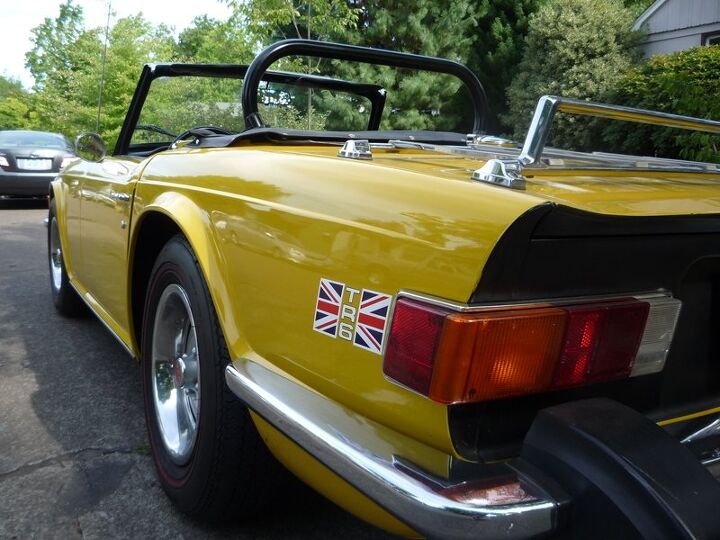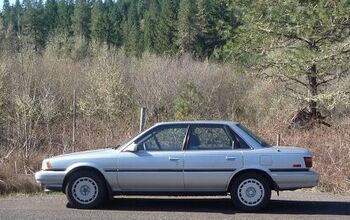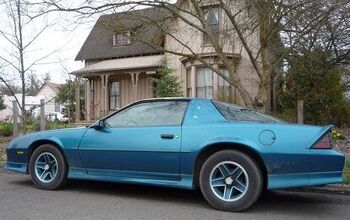Curbside Classic: Triumph TR-6

For decades, British roadsters had a spell on Americans. And the rivalry between the MG and Triumph, the two leading exponents of the genre, was legendary. They each had loyal adherents to the respective marques, and the stiff competition kept the improvements coming, even if not exactly at a breakneck pace. But by about the time this TR-6 first appeared in 1969, the race was essentially over: the new MGC was DOA, and the MGB was quickly slipping into its ossification period, while the Triumph reveled in its final incarnation of the classic formula: old school, but with a healthy kick of life in it yet.
The TR Series began with the 1953 TR-2. Always a notch more powerful and expensive than the corresponding MG, the TR-2 established not only the TR formula, but was the very basis for the whole series until the all-new TR-7 appeared in 1975. The TR-6 is a direct descendant of that hoary and rough-riding TR-2, including its old-school body-on-frame (BOF) construction.
Meanwhile, the MGs enjoyed a much more vigorous rate development, given that in 1953, the MG’s TD was still very nineteen-thirties in look and feel. MG’s went through at least three major new platforms, and the MGB was a substantially more modern unibody design than the corresponding TR-4. Not that it made much difference.
Triumph’s underdog status always led to creative and incremental solutions, and the TR range continued to evolve in ways that most directly addressed its most immediate shortcomings. The 1961 TR-4 had a handsome new body designed by Michelotti, and rack and pinon steering. In 1965, The TR-4A was blessed with an independent rear suspension to tame the very much alive rear axle. And in 1967, the TR-5, oddly called TR-250 in the US, finally replaced the rude old four cylinder with a much smoother and lusty 2.5 L six. And yes, it’s true; the old four really was a design that was also used in a Ferguson tractor engine, for what its worth. The Brits liked a bit of sportiness while plowing the field.
The TR-5 is my personal favorite of the bunch including the TR-6, since I’m rather fond of the earlier Michelotti design, which looked its best with the revised grille on the TR-5. With its 150hp fuel-injected engine (not in the US), it had quite brisk performance for its day, not to mention a lovely exhaust note. And with the overdrive, one had seven gears to play with. Triumph’s first sports car, the Roadster, was an attempt to compete with Jaguar’s XK series, at lower cost. The TR-5 and 6, with their six cylinders and more refined suspensions, finally approached that goal of a poor mans Jag.
Even though I’m not so hot about the TR-6’s styling, which was obviously a low-budget face and tail lift done with help from Karmann re-using the TR-4’s center section, it has its charms, especially if British Roadsters are one’s thing. It’s clearly the most vibrant, appealing and civilized of its era, given the how the MGB became such a pathetic thing, with its hippo-nose, jacked up suspension and feeble 77hp four. The TR-6’s arrival was embraced; the MGB’s decline could only be endured, at best.
The TR-6 appeared in 1969 with generally enthusiastic reviews, as the old TR magic was still to be found in the right settings. Since US bound TR-6s had a desmogged engine with only 104 hp to the British market’s 150 hp, acceleration in that era of Detroit muscle cars was hardly breathtaking. But it had a useful torque curve, and certainly sounded right, especially with the top down. Ergonomically, the Triumph was obviously still old school: a narrow and cramped little cabin; getting in was more like sliding into a sleeping bag. But there was that handsome dash board (literally) to savor as a compensation to the lack of comforts.
The TR-6 was the best selling of the TR series so far, and some 95 k were made from ’69 through 1976. The fact that 86k of those were exported gives a pretty clear picture what the intended market for the TR-6 was. They might just as well have put the Stars and Stripes on its flank instead of the Union Jack.
The beginning of the end happened about the same time this TR-6 first appeared in 1969, and reflected the relative dynamic qualities of the two parent companies that had just merged to form British Leyland. The much smaller Leyland was essentially called on to bail out the moribund BMH (formerly BMC). Leyland was clearly the better managed of the two, but it quickly got bogged down in the mind boggling morass of over 100 companies that made up the new company, making everything from appliances to tractors (real ones, that is). Soon, the government would have to bail out the sinking conglomerate.
It was clear that Triumph, as part of the original Leyland would get preference over MG in the sports car segment, and an all-new TR-7 would soon see the (dismal) light of day as a replacement for the the TR-6. But that’s the story for another CC. TR-6s like this obviously nicely restored one enjoy an enthusiastic following. Its engine is easily upgraded for a bit more punch, and its ride is much less punishing than its predecessors. Just the ticket for as summer’s day drive into the mountains.
Top Gear TR6 segment here: http://www.youtube.com/watch?v=iL0JQJNnLWo

More by Paul Niedermeyer
Latest Car Reviews
Read moreLatest Product Reviews
Read moreRecent Comments
- Calrson Fan Jeff - Agree with what you said. I think currently an EV pick-up could work in a commercial/fleet application. As someone on this site stated, w/current tech. battery vehicles just do not scale well. EBFlex - No one wanted to hate the Cyber Truck more than me but I can't ignore all the new technology and innovative thinking that went into it. There is a lot I like about it. GM, Ford & Ram should incorporate some it's design cues into their ICE trucks.
- Michael S6 Very confusing if the move is permanent or temporary.
- Jrhurren Worked in Detroit 18 years, live 20 minutes away. Ren Cen is a gem, but a very terrible design inside. I’m surprised GM stuck it out as long as they did there.
- Carson D I thought that this was going to be a comparison of BFGoodrich's different truck tires.
- Tassos Jong-iL North Korea is saving pokemon cards and amibos to buy GM in 10 years, we hope.








































Comments
Join the conversation
As an owner of a '74 TR6 for the past 35 yrs. I have really enjoyed these comments by so many TR fans. Yes, it's an old car ( even when it was new); but, the fun quotient is still there as much as when I used to drive it back and forth from Toronto to Ottawa 25 yrs. ago at speeds that the traffic doesn't drive to-day, and a trip I took down to Virginia Beach. The car has been very reliable, never letting me down. Right now, I'm having the engine compartment detailed and adding the green hoses and plug wires and a few other good looking pieces. Yes, it's primitive by modern standards; but, ultimately, a TR6 is a state of mind. You either get it or you don't. For those of you with or getting TR's, PRESS ON !!
British Leyland or British Rail? Hard to know which was the more reliable commute of the day...